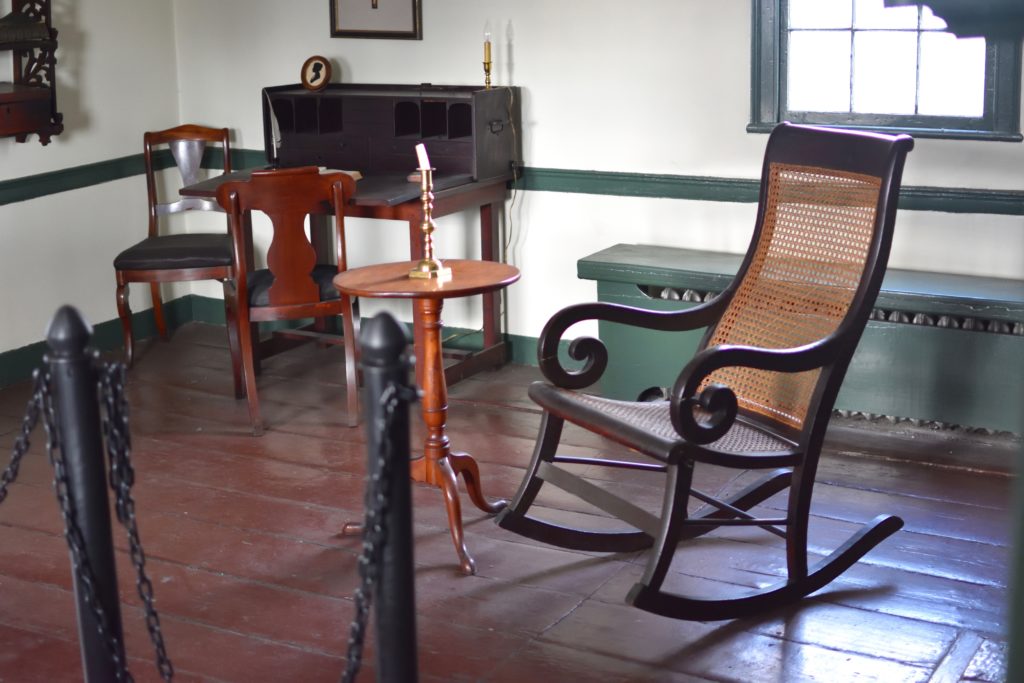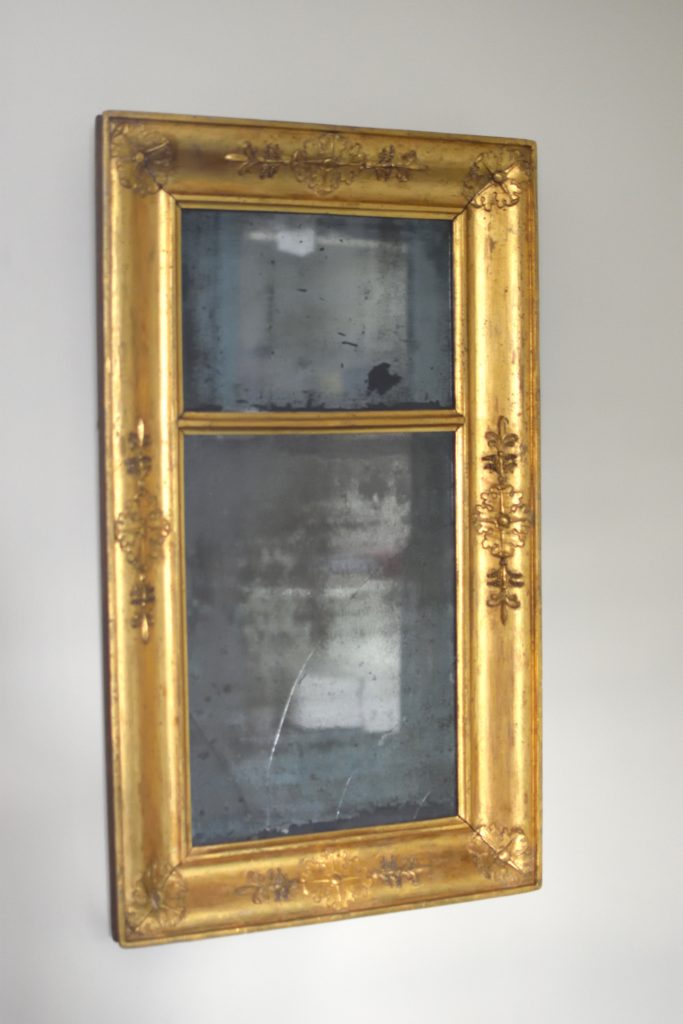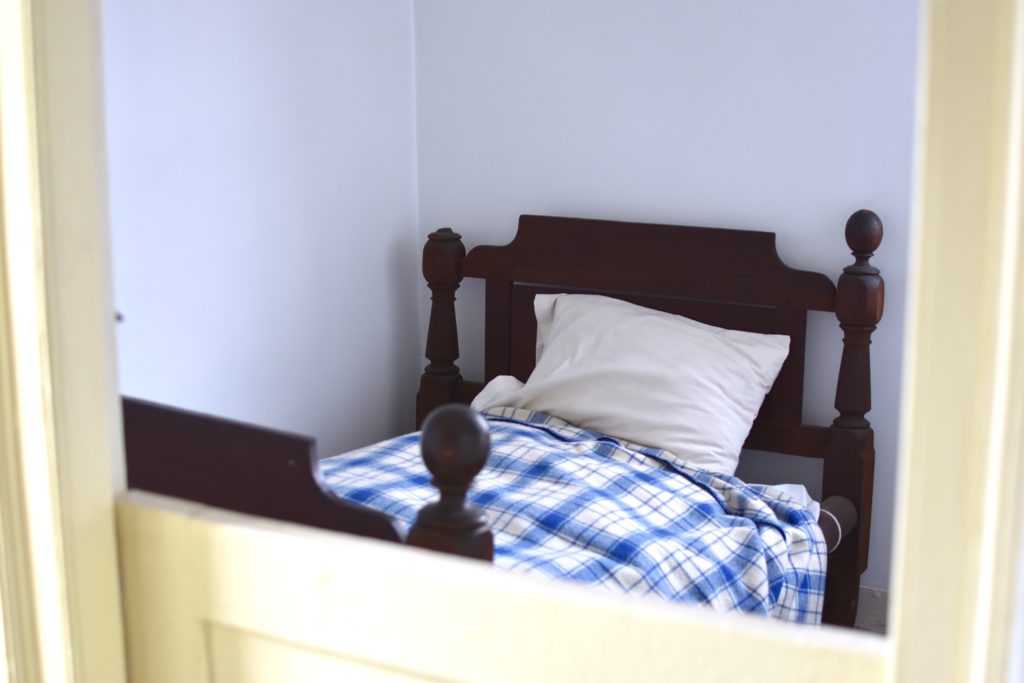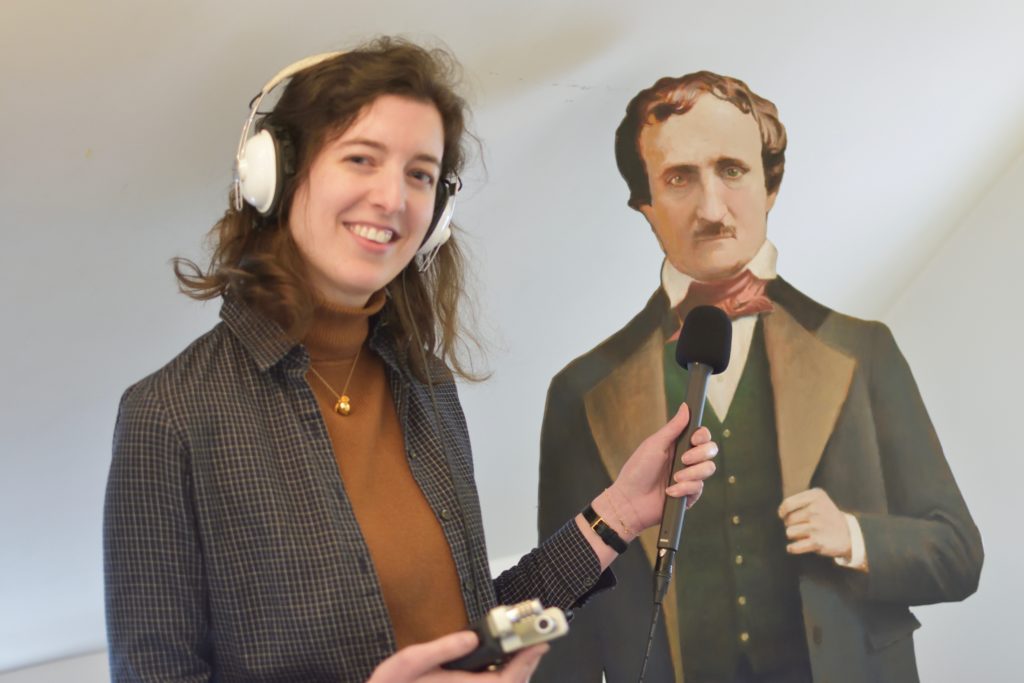Explore the final home of the writer and poet

Apple | Spotify | Stitcher | Transcript | Email | Bonus Episode
Listen to the 7-minute bonus episode for Edgar Allan Poe Cottage which includes recordings and stories I couldn’t fit in the original episode. We talk about how I struggled to parse the truth about such a revered writer, I also learned more about his wife and a missing Daugerrotype. You can listen by joining Someone Lived Here’s Patreon at any level.
In this episode of the podcast Someone Lived Here, Kendra brings you to Edgar Allan Poe Cottage in the Bronx. This unassuming cottage was the final home of the writer Edgar Allan Poe and the home his young wife and cousin, Virginia Clemm Poe, died in.
In this episode, we walk through the small cottage, learn more about the man, his addiction and his writing. We see the items he and Virginia owned, a rocking chair, a mirror, and the bed Virginia died in.
Thank you to Vivian Davis, the Bronx Historical Society, and the Historic House Trust. You can see the Edgar Allan Poe Cottage visiting hours on their website.
Special thanks to Via Perkins who took photos of the cottage below. Music by Tim Cahill. Icon artwork by Ben Kirk. Transcription by Sam Fishkind.



Below is a transcript for season 1, episode 6 of Someone Lived Here at Edgar Allan Poe Cottage in Bronx, NY. If you have any questions about the show or suggestions on how to make it more accessible please reach out at someonelivedhere@gmail.com.
Transcript by Sam Fishkind
Kendra Gaylord: This week we’re at Poe Cottage in the Bronx. The small white cottage was a home of Edgar Allan Poe. He moved to what was then the country, with the hope that the fresh air would help cure his wife (and cousin) of tuberculosis. She died in the home, and he would die under mysterious circumstances a few years later. His death began a century’s long journey to preserve his final home. Welcome to Someone Lived Here, a podcast about the places people called home. I’m your host, Kendra Gaylord. Every other Monday this season, we’re bringing you to a cool place in New York and telling the complicated stories of the people who once lived there. Today we’re at the corner of Poe Park in Fordham. The cottage is simple and sweet, and looks out of place alongside the nine-story apartment buildings and the cars that aren’t Model Ts. It’s believed that Poe’s last story, “Landor’s Cottage”, was written about this very spot in New York. But people who like Poe’s other works are often disappointed with what they read. A review on GoodReads by Natalie says, “some guy gets lost in the woods and comes upon a cottage that he loves, loves, loves, loves, loves, and he spends pages gushing about how perfect everything looks at the cottage.” Well, conveniently for us, we’re a podcast that gushes about colleges. Here’s a little bit from that story: “In fact, nothing could well be more simple, more utterly unpretending than this cottage. Its marvellous effect lay altogether and its artistic arrangement as a picture. I could have fancied, while I looked at it, that some eminent landscape painter had built it with his brush.” The home has a kitchen, and a parlor, and three small bedrooms. The second floor is tucked within the gabled roof, meaning there are slanted ceilings and plenty of opportunities to bonk your head. To learn more about Poe, his wife, and the home they shared, I spoke with Vivian Davis. She is the Education Coordinator at the Bronx Historical Society, who run the Edgar Allan Poe Cottage.
Vivian Davis: Poe was born in 1809 in Boston, Massachusetts to actors, and he was going around with his family as they were acting. And unfortunately, he didn’t really get to know his parents very well. He did have a sister, and that relationship was strained as well during his lifetime. But his mother died of tuberculosis when Poe was very young, and his father was out of the picture as well. We’re not quite sure about the father, but he was adopted into the Allan family, which is why he has the middle name of Allan. He lived down in Richmond, Virginia, during the formative years.
Kendra Gaylord: John Allan had also been an orphan and had become a merchant with the assist of his uncle, William Galt. John Allan exported tobacco and other luxuries, and worked extremely closely with plantations. He would also trade in slave people, and profit by hiring them out to the coal mines. John Allan and his wife Francis had no children of their own. Poe’s relationship with his foster father was complicated, and his style of parenting shifted from spoiling and scolding, but his foster mother Francis was loving and kind, but often sick – and as Poe entered his teen years, his relationship with his foster father became tense.
Vivian Davis: He went to to college for a while at the University of Virginia. And from there, he realized his love of writing.
Kendra Gaylord: He studied Latin while at the University of Virginia. He also began gambling, and racked up debts. He and his foster father clashed over the cause of the debts and were estranged. Poe would leave after a year and enlist in the United States Army under the name Edgar A. Perry. It was during this time in the army that he wrote his first book of poetry with the byline “A Bostonian”, but the book received minimal attention. In two years, his foster mother died. It was after her death that he and his father briefly reunited. Poe wrote in a letter to him, “if she had not have died while I was away, there would have been nothing for me to regret. She, I believe, loved me as her own child.” Poe was 20. This was another loss of a mother figure. The renewed father-son relationship didn’t last long. Their correspondences about money help explain why. Poe would spend the next seven years bouncing around the Eastern seaboard, leaving the U.S. Army, joining West Point, getting kicked out of West Point. He began working for a monthly magazine in Richmond, Virginia. Its founder, Thomas Willis White, saw the paper as the spokesman of Southern culture, with an emphasis on morality. Thomas White requested Poe’s help as an assistant editor. White appreciated Poe’s skills, but was quite surprised by his emotional volatility and alcohol usage. In the biography “Edgar Allan Poe: His Life and Legacy”, the author Jeffrey Meyers describes Poe’s relationship with alcohol:.
Sound Effect: [Gentle guitar music begins]
Kendra Gaylord: “Temperance was for him more difficult than abstinence. Once he started to drink he was unable to stop until he ran out of money or fell into a stupor. Poe was the kind of alcoholic who could abstain for months at a time and then suddenly lose control, start to drink excessively and continue to do so for days”.
Sound Effect: [Gentle guitar music continues]
Kendra Gaylord: Now, I want to introduce you to a cousin of Edgar Allan Poe. It wasn’t the cousin he would marry, but the one who would accidentally spur that decision. His name was Neilson Poe, and he was born four months after Edgar. Neilson Poe was an editor of several newspapers, and the owner of the Baltimore Chronicle. Edgar called him his “bitterest enemy”. Neilson was married to Josephine Clemm, who was also his first cousin. Neilson and Josephine had been married for five years when they offered to be Virginia’s guardian, educate her and introduce her in society. They knew that Edgar was interested in Virginia and hoped to marry her. Virginia was 13 at the time.
Sound Effect: [Guitar music ends with a strum.]
Kendra Gaylord: Edgar saw Virginia and Josephine’s mom, Maria Clemm, as a close mother figure. When she informed him of the planned arrangement with Neilson, the letter he replied with is best described as manipulative: “I am blinded with tears while writing this letter — I have no wish to live another hour. Amid sorrow, and the deepest anxiety your letter reached — and you well know how little I am able to bear up under the pressure of grief. My bitterest enemy would pity me could he now read my heart. My last my last my only hold on life is cruelly torn away — I have no desire to live and will not . But let my duty be done. I love, you know I love Virginia passionately devotedly. I cannot express in words the fervent devotion I feel towards my dear little cousin — my own darling.” He also included a short note, and $5: “For Virginia. My Love, my own sweetest sissy, my darling wifey, think well before you break the heart of your dear cousin Eddie.” The letter worked, and Virginia and Edgar were married within the year. She was still 13 and Poe was 27. At the ceremony, they said she was 21, and that began the marriage that put Edgar, Virginia and Maria Clemm under the same roof; and at one point, that roof would be the one we’re underneath right now. Edgar found himself out of a job when Thomas Wiles White let him go for the third and final time (once again related to his drinking). The pair; and often the trio, would move from place to place. Maria was smart, and always managed to bring in money for the family even when Edgar’s writing didn’t. The three lived in Philadelphia for two and a half years. Edgar had made a total of $143, which even then was very little. He then got a job as an assistant editor of Burton’s Gentlemen Magazine. The founder and Edgar constantly battled. In 1840, Edgar saw his time closing in, and announced that he would have his own magazine: The Pen. Burton fired him immediately, and The Pen never materialized. Edgar would find himself at a different magazine, Graham’s, in 1841, where he was paid $800 a year. There he popularized code-breaking and ciphers, and wrote detective and adventure stories that required a puzzle to be solved. Edgar had an increase in salary and more interesting work, but things became more complicated.
Vivian Davis: And unfortunately with Virginia in 1842, she contracted tuberculosis, which back then was called consumption; root word: consume. It consumed you. Apparently, the story goes that she was playing the piano one night and all of a sudden coughs up blood.
Kendra Gaylord: When I think of coughing up blood, I usually think of someone in a BBC special coughing up a small amount of blood on a monogrammed handkerchief. But according to descriptions of the event, it was extremely scary and violent. A quote from the Meyers’ biography reads, “the blood gushed from her mouth and her life was in danger. She partially recovered, only to sink, like a drowning survivor, again and again.”. Many people close to Edgar died of consumption, including his mother. And now his wife, at the age of 20, began her journey with the same disease. The family would move to New York. He began working at a new publication called the Broadway Journal. Edgar would get a third of the profits. Unfortunately, the magazine was less successful than any of his previous employers. He bought the Broadway Journal, and it failed a few months later. But there were victories too: it was in New York that Edgar wrote and published “The Raven” and suddenly found himself famous. With his new fame, he found himself around women in the literary world who were interested in him. His most successful relationship was with Fanny Osgood, and seemed centered around their writing. Their friendship was encouraged by Virginia, with the hope that focusing on Fanny might distract him from drinking. It was around this time that Edgar, Virginia and Maria would move to the little cottage in Fordham that we’re in today. The hope was that the fresh air would help cure Virginia’s TB, but after a year and a half, Virginia was on the edge of death in the small bedroom on the first floor. Vivian is now going to walk us through the house. There’s also going to be some noise in the background here. The home doesn’t have much insulation, and is located at a very busy intersection. We’re in the upstairs bedroom now, which Edgar in Virginia shared.
Vivian Davis: And welcome to the bedroom. It’s a really nice size space. It’s a big bedroom, you know, even for us today, it’s a pretty big bedroom. Naturally on the plain wall over here, it would have been where the bed would have been. Because there was no bathrooms or no showers or – there were tubs, but no showers, no running water through this place. You didn’t bathe every day; as what we think of bathing is. You didn’t take a shower everyday. You didn’t get into a bath every day – you took sponge baths every day. So in one of the corners, there would’ve been a basin of water, a sponge, some soap for you to get in the morning and at night. And that would’ve been in here as well. What else in furniture…chairs and some drawers to put your stuff in.
Kendra Gaylord: Virginia and Edgar shared this room until Virginia got so sick she had to be carried up and down the stairs. There’s one other room upstairs that was used as Edgar’s office where he could be found writing with this cat, Catarina, perched on his shoulders. Now we’re going to head downstairs to the parlor.
Vivian Davis: So in this room, you have one of our treasures, which is the rocking chair, which was owned by Edgar Allan Poe. Yes, and it’s not too terrible looking for 170 years old, so we like to keep our items and in good shape.
Kendra Gaylord: There’s one other item that belonged to Edgar and Virginia in the parlor. It’s a gold-painted mirror with a magnifying panel up above. It also has that haze that you only see in really old mirrors, and there’s a bit of a ghost story that goes along with it.
Vivian Davis: That mirror, so, that was when the students saw, supposedly Poe’s face in the mirror and took video of it. So we have some video of that. Like I said, whether or not it was him, you never know. It’s up to you.
Kendra Gaylord: I haven’t seen the video yet, but if I were going to haunt a mirror, it would definitely be the spooky one. In the final months of Virginia’s life, the family had a visitor in Mary Gove. She was a novelist and health lecturer, who would regularly check in on the Poe family and later wrote about it. She said of the space, “the cottage had an air of taste and gentility that must have been lent to it by the presence of its inmates. So neat, so poor, so unfurnished and yet so charming a dwelling I never saw. This brings us to the final room of this tour: the small bedroom on the first floor where Virginia died…and the same bed frame is still there.
Vivian Davis: So, come on in.
Sound Effect: [Wooden door opening]
Vivian Davis: The majority of the mattresses at the time were of down feather. However, below that.
Sound Effect: [Rustling sound].
Vivian Davis: You have a rope bed. And that’s where the saying “good night, sleep tight” comes from – because you have to tighten up the ropes to get more of a firm feel for the bed when you sleep in it. There was a key, a rope key that you would use to tighten up the bed. They’re very comfortable.
Kendra Gaylord: Mary Gove also wrote of what she saw in that room: “there was no clothing on the bed, which was only straw, but a snow-white spread and sheets. The weather was cold and the sick lady had the dreadful chills that accompanied the hectic fever of consumption. She lay on the straw bed wrapped in her husband’s great coat with a large tortoiseshell cat on her bosom. The wonderful cat seemed conscious of her great usefulness. The coat and the cat were the sufferer’s only means of warmth, except as her husband held her hands and her mother held her feet.”.
Kendra Gaylord: Virginia Clemm died at the age of 24, the same age Edgar’s mother and his brother were when they died of TB. After her death, realizing he had no photos or paintings of Virginia, Edgar commissioned a watercolor portrait. I looked at this painting countless times while researching: something in image always looked a little off, like she wasn’t totally there…and that’s because she no longer was. Both Maria and Edgar deeply felt the loss of Virginia. They would continue to live together in the cottage they all had shared. Edgar continued to write, proposed to women, continued drinking, attempted to start his own magazine…He traveled up and down the East Coast…
Sound Effect: [Guitar music ends.]
Kendra Gaylord: As if on tour. After a successful lecture in Richmond, he was traveling back, and stopped in Baltimore. On September 28th, he got drinks with some friends, and then was not seen for six days. He was found on October 3rd. He was not in his own clothing. He was then sent to a hospital in horrible condition, suffering from a fever and hallucinations. He died on October 7th. Based on the timeline of events of his final days, it would make sense that Edgar Allan Poe died of an alcohol withdrawal, but because of the public opinion towards alcohol during the temperance movement, there are wild theories that exclude drinking – ranging from rabies to election fraud. Edgar’s cousin, Neilson Poe, paid for the hearse and the marble headstone. After Poe’s death, Maria would move out of their little cottage in the country.
Kendra Gaylord: She would live to be 80, outliving her son and daughter and the nephew she gave so much of herself to. Thank you for listening to Someone Lived Here. I’m your host, Kendra Gaylord. If you’ve been liking these episodes, you can write us a review on Apple Podcast, and be sure to subscribe to hear next week’s episode – it will be the final episode of this season and tells the story of Edna St. Vincent Millay and her property, Steepletop. Thanks to Vivian Davis, the Bronx Historical Society, and the Historic House Trust. Special thanks to Via Perkins, who took photos of the cottage, which can be seen at someonelivedhere.com. Music is by Tim Cahill, and podcast artwork is by Ben Kirk. If you have any notes or recommendations for the show, send us an email at someonelivedhere@gmail.com.